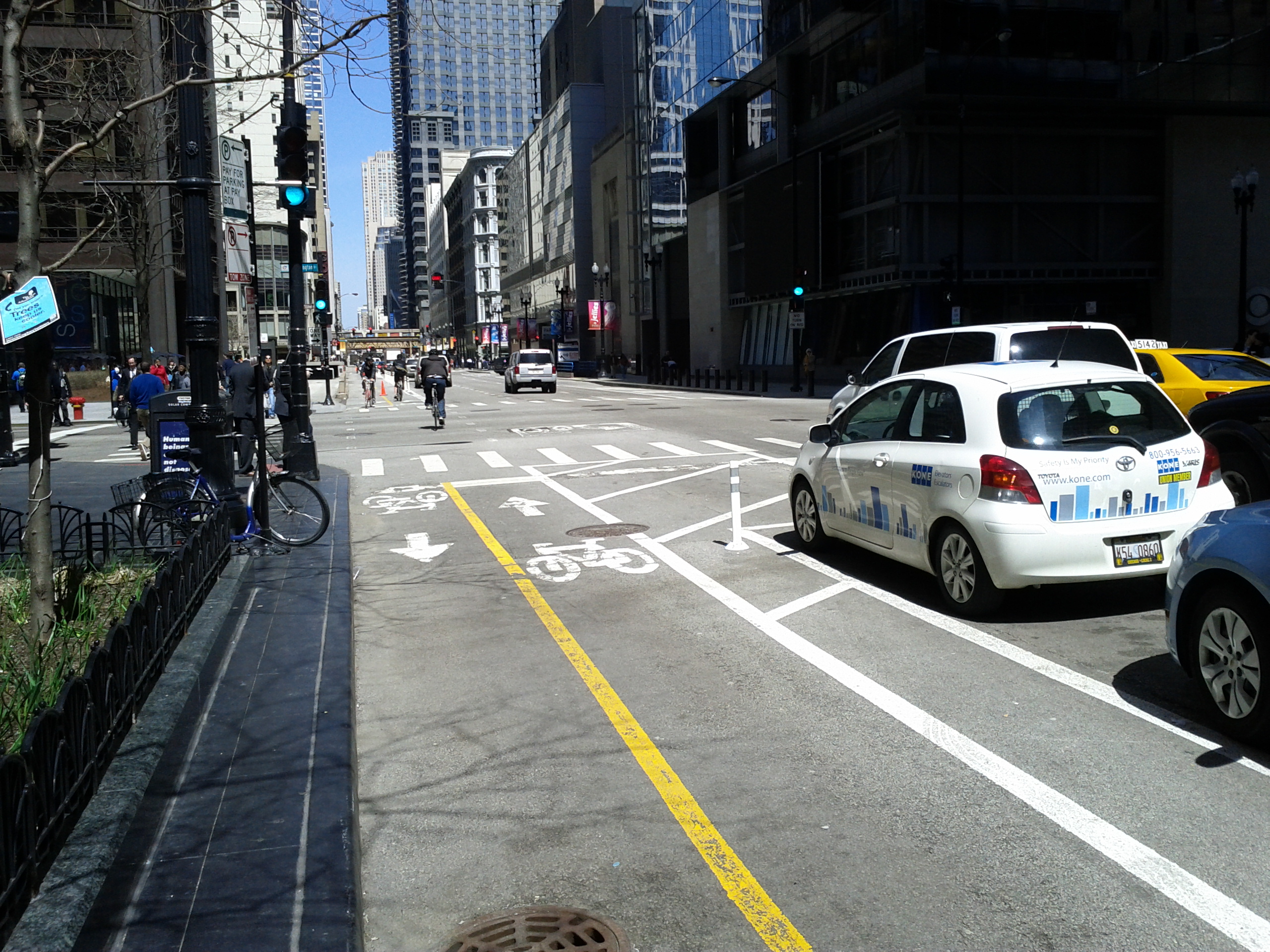
IN THIS ISSUE:
Chicago Opens First Two-Way Protected Bike Lane in the Loop
Modular Apartments in Portland, Oregon
Grantee Spotlight: A Plan to Foster Community Development and Benefit Residents in Southeast D.C.
Chicago Opens First Two-Way Protected Bike Lane in the Loop

Dearborn Street’s two-way protected bike lane (shown near the intersection of Dearborn and Washington Street) accommodates bicycle commuters in Chicago’s central business district. Image courtesy of the Chicago Department of Transportation.
Chicago has a long history of supporting cycling. The city opened its first bike trail in 1963 and its first on-street bike lane in 1971. The city’s Bicycle Advisory Council prepared bicycle plans in 1992 and 2006 that have guided the growth of Chicago’s bike network, leading Bicycling magazine to name Chicago the country’s fifth most bicycle-friendly city in 2012. More than 130 miles of standard bike lanes, 40 miles of shared bike lanes, 18 miles of buffer-protected bike lanes, and 12 miles of barrier-protected bike lanes had been installed by 2012, when the Chicago Department of Transportation (CDOT) released the Chicago Streets for Cycling Plan 2020. The plan furthers the city’s commitment to cycling and sets a goal of providing bicycle accommodations within a half mile of every Chicago residence, as well as expanding the bicycle network to 645 miles by 2020. One of the plan’s interim targets is to create 100 miles of protected lanes by 2015.
Features of Protected Bike Lanes
After the first one-way, barrier-protected bike lane was installed on a half-mile stretch of Kinzie Street in 2011, Chicago opened its first barrier-protected, two-way bike lane on Dearborn Street in December 2012 to promote cycling on a high-profile, busy street in the central business district (the Loop). Protected bike lanes are a relatively new type of facility that Plan 2020 calls for to encourage bicycle use and improve bike safety on Chicago’s 21st century bicycle network.
Unlike standard bike lanes, protected bike lanes are separated from motor vehicle traffic. CDOT classifies protected bike lanes as either buffer-protected lanes, which separate cyclists from traffic by providing a wide, marked space (without a physical barrier) on one or both sides of the lane, or barrier-protected lanes, which use a physical barrier such as raised medians, posts, and on-street parking.
Barrier-protected bike lanes are CDOT’s preferred form of bicycle infrastructure for streets at least 58 feet wide. They can be either one-way or two-way lanes; one-way lanes allow cyclists to travel in one direction on one or both sides of a street, whereas two-way lanes permit cyclists to travel in both directions on one side of the street and are typically used on one-way streets. Buffer-protected lanes can be incorporated into streets that are at least 48 feet wide, but CDOT prefers a minimum 50-foot width.
Benefits of Protected Bike Lanes
Protected bike lanes are intended to encourage safe bicycling, a healthy, sustainable, and affordable method of transportation, even in Chicago’s cold winters. Although using protected bike lanes still poses a risk, especially at alley crossings, intersections, and driveways, they can help reduce the risk of collisions between cyclists and automobiles and encourage more people to bicycle as a mode of transportation.
According to CDOT data, protected bike lanes are reducing accidents and increasing bicyclists’ perception of safety. Both ridership and perceived safety have increased in Chicago’s protected bike lane on Kinzie Street. In other urban areas, New York City has witnessed a decrease in injuries in the areas around the one-way barrier-protected bike lanes on 8th and 9th avenues and has seen an increase in ridership around the protected bike lane on Grand Street. In Washington, D.C., ridership has also increased on the protected bike lane on 15th Street Northwest.
One Link in the Citywide Bicycling Network
In addition to being the first two-way, barrier-protected bike lane in Chicago, the Dearborn Street lane is also the first barrier-protected bike lane in the Loop. The city considers the Dearborn Street bike lane to be one of its “spoke routes,” which connect the central business district to all parts of the city. The bike lane on Dearborn Street stretches 1.15 miles from Polk Street inside the Loop to Kinzie Street outside of the Loop, using bicycle-specific traffic signals to guide cycling commuters.
The placement of the protected bike lane on Dearborn Street balances the needs of cyclists, drivers, and public transit. Located on the left-hand side of a one-way street and protected by a parking lane, the bike lane allows room for two lanes of northbound automobile traffic and accommodates buses, which run on the right side of the street. Sidewalks along the street permit easy pedestrian travel, and Chicago’s subway line runs underneath Dearborn Street, connecting bicycle commuters to the larger Chicago area. According to Mike Amsden, CDOT Project Manager, the bike lanes help make Dearborn Street a good example of a “complete street.”
The barrier-protected, two-way bike lane on Dearborn Street is only one part of Chicago’s plan to build on its 21st-century bicycle network and create more complete streets. Chicago recently joined five other U.S. cities in the Green Lane Project, a two-year campaign of the Bikes Belong Foundation to produce world-class networks of protected bike lanes in the United States.
